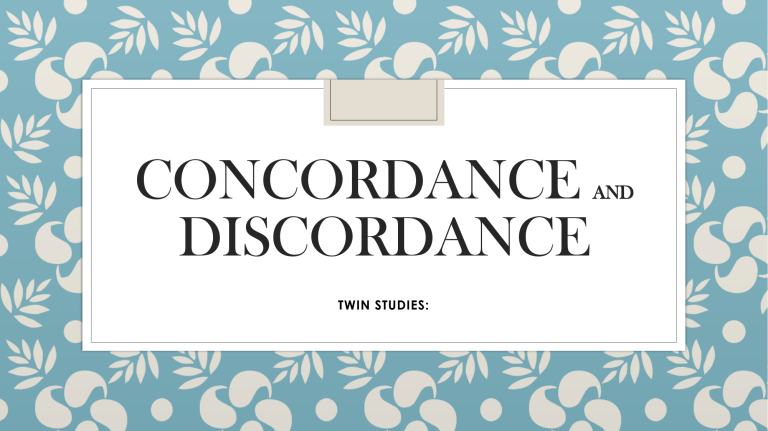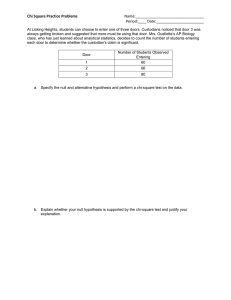
CONCORDANCE DISCORDANCE TWIN STUDIES: AND CONCORDANCE ◦ The presence of the same trait in both members of a pair twins Ex. ◦ Identical twins DISCORDANCE ◦ Twin pairs do not have the same trait Ex. ◦ Fraternal twins PROBABILITY STATISTICAL TESTING AND Level of Significance ◦ Say that you are performing a genetic cross in which you know the genotypes of the parents. In this situation, you might hypothesize that the cross will result in a certain ratio of phenotypes in the offspring. But what if your observed results do not exactly match your expectations? How can you tell whether deviation was due to chance? this ◦Once you have performed an experiment, how can you tell if your results are significant? Chi-square Test ◦ Used to see if observed values for a set of data are similar or significantly different from expected values The chi-square value is calculated using the following formula: Using this formula, the difference between the observed and expected frequencies is calculated for each experimental outcome category. The difference is then squared and divided by the expected frequency. Finally, the chi-square values for each outcome are summed together, as represented by the summation sign (Σ). Chi-square test can only be applied to numbers of progeny, not to proportions or percentages. ◦ Recall that when Mendel crossed his pea plants, he learned that tall (T) was dominant to short (t). You want to confirm that this is correct, so you start by formulating the following null hypothesis: In a cross between two heterozygote (Tt) plants, the offspring should occur in a 3:1 ratio of tall plants to short plants. Next, you cross the plants, and after the cross, you measure the characteristics of 400 offspring. You note that there are 305 tall pea plants and 95 short pea plants; these are your observed values. Meanwhile, you expect that there will be 300 tall plants and 100 short plants from the Mendelian ratio. ◦ you have to choose a critical value at which to reject your null hypothesis. You opt for a critical value probability of 0.01 (1%) that the deviation between the observed and expected values is due to chance. This means that if the probability is less than 0.01, then the deviation is significant and not due to chance, and you will reject your null hypothesis. However, if the deviation is greater than 0.01, then the deviation is not significant, and you will not reject the null hypothesis. So, should you reject your null hypothesis or not? Here's a summary of your observed and expected data: Tall Short Expected 300 100 Observed 305 95 Now, let's calculate Pearson's chi-square: •For tall plants: Χ2 = (305 - 300)2 / 300 = 0.08 •For short plants: Χ2 = (95 - 100)2 / 100 = 0.25 •The sum of the two categories is 0.08 + 0.25 = 0.33 •Therefore, the overall Pearson's chi-square for the experiment is Χ2 = 0.33 Table 1: Chi-Square Table DegreesProbability (P) 0.99 of0.995 Freedom (df) 1 ----2 0.010 0.020 3 0.072 0.115 4 0.207 0.297 5 0.412 0.554 6 0.676 0.872 7 0.989 1.239 8 1.344 1.646 9 1.735 2.088 10 2.156 2.558 11 2.603 3.053 12 3.074 3.571 13 3.565 4.107 14 4.075 4.660 15 4.601 5.229 16 5.142 5.812 17 5.697 6.408 18 6.265 7.015 19 6.844 7.633 0.975 0.95 0.90 0.10 0.05 0.025 0.01 0.005 0.001 0.051 0.216 0.484 0.831 1.237 1.690 2.180 2.700 3.247 3.816 4.404 5.009 5.629 6.262 6.908 7.564 8.231 8.907 0.004 0.103 0.352 0.711 1.145 1.635 2.167 2.733 3.325 3.940 4.575 5.226 5.892 6.571 7.261 7.962 8.672 9.390 10.117 0.016 0.211 0.584 1.064 1.610 2.204 2.833 3.490 4.168 4.865 5.578 6.304 7.042 7.790 8.547 9.312 10.085 10.865 11.651 2.706 4.605 6.251 7.779 9.236 10.645 12.017 13.362 14.684 15.987 17.275 18.549 19.812 21.064 22.307 23.542 24.769 25.989 27.204 3.841 5.991 7.815 9.488 11.070 12.592 14.067 15.507 16.919 18.307 19.675 21.026 22.362 23.685 24.996 26.296 27.587 28.869 30.144 5.024 7.378 9.348 11.143 12.833 14.449 16.013 17.535 19.023 20.483 21.920 23.337 24.736 26.119 27.488 28.845 30.191 31.526 32.852 6.635 9.210 11.345 13.277 15.086 16.812 18.475 20.090 21.666 23.209 24.725 26.217 27.688 29.141 30.578 32.000 33.409 34.805 36.191 7.879 10.597 12.838 14.860 16.750 18.548 20.278 21.955 23.589 25.188 26.757 28.300 29.819 31.319 32.801 34.267 35.718 37.156 38.582 ◦ At the beginning of your experiment, you decided that if the probability was less than 0.01, you would reject your null hypothesis because the deviation would be significant and not due to chance. Now, looking at the row that corresponds to 1 degree of freedom, you see that your calculated chi-square value of 0.33 falls between 0.016, which is associated with a probability of 0.9, and 2.706, which is associated with a probability of 0.10. Therefore, there is between a 10% and 90% probability that the deviation you observed between your expected and the observed numbers of tall and short plants is due to chance. In other words, the probability associated with your chi-square value is much greater than the critical value of 0.01. This means that we will not reject our null hypothesis, and the deviation between the observed and expected results is not significant. Sources ◦ https://www.nature.com/scitable/topicpage/genetics-and-statistical-analysis-34592 ◦ https://www.healthychildren.org/English/family-life/family-dynamics/Pages/TheDifference-Between-Identical-and-Fraternal-Twins.aspx ◦ https://www.youtube.com/watch?v=DvQZdxMRtls ◦ https://www.britannica.com/science/dizygotic-twin




